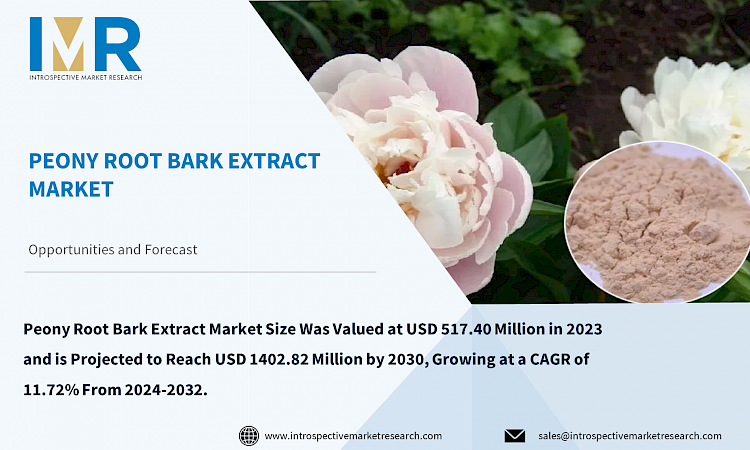Peony Root Bark Extract Market
According to a new report published by Introspective Market Research, titled, ?Peony Root Bark Extract Market by Application and Type: Global Opportunity Analysis and Industry Forecast, 2024?2032,?
The Global Peony Root Bark Extract Market Size Was Valued at USD 517.40 Million in 2023 and is Projected to Reach USD 1402.82 Million by 2030, Growing at a CAGR of 11.72% From 2024-2032.
Peony Root Bark Extract, derived from the root bark of the peony plant, is highly regarded for its medicinal properties. The extraction process concentrates its bioactive compounds, which possess anti-inflammatory, antioxidant, and analgesic effects. This extract is a prominent ingredient in traditional and herbal medicine, used to alleviate pain and inflammation associated with arthritis and menstrual cramps. Its antioxidant properties help combat oxidative stress, promoting overall well-being. Additionally, Peony Root Bark Extract is popular in skincare products for its ability to soothe irritated skin and reduce redness, making it a favored component in cosmetics and topical formulations.
The natural anti-inflammatory and antioxidant properties of Peony Root Bark Extract offer a gentle yet effective approach to pain management and skin health. As more consumers seek natural remedies and skincare solutions, the demand for botanical extracts like Peony Root Bark Extract is expected to rise. Ongoing research into its medicinal properties may reveal further health benefits, driving even greater demand for products containing this extract. With an increasing emphasis on natural alternatives for pain relief, inflammation management, and skincare, Peony Root Bark Extract is well-positioned for continued growth in the market.
According to The Peony Root Bark Extract Market is segmented into Type, Application, Distribution Channel, and region. By Type, the market is categorized into Powder, Extract, Capsule, and Tablet. By Application, the market is categorized into Pharmaceuticals, Food & Beverages, Personal Care, Cosmetics, and Dietary Supplements. By Distribution Channel, the market is categorized into Online Retail, Pharmacies, Offline Retail, and Specialty Stores. It includes North America, Europe, Asia-Pacific, and LAMEA markets by geography. Further, the report also covers the strategies adopted by key market players to sustain a competitive environment and increase their market share.
The Peony Root Bark Extract market is growing due to the increasing demand for natural and organic products. Consumers prioritize health and environmental consciousness, leading to a preference for botanical extracts like Peony Root Bark Extract, known for its natural and holistic properties. Its extensive use in traditional Chinese medicine for anti-inflammatory and analgesic benefits has boosted its recognition as a therapeutic alternative to conventional pharmaceuticals, appealing to those seeking natural remedies. Additionally, the beauty and skincare sectors are incorporating Peony Root Bark Extract into formulations for its skin health benefits, driving the market growth.
Advancements in personalized medicine applications present significant opportunities for the Peony Root Bark Extract market. With healthcare technology and genomic research enabling tailored treatments based on individual genetic profiles, there's a growing trend towards integrating botanical extracts like Peony Root Bark Extract into personalized medicine. Its therapeutic properties make it a valuable ingredient in personalized healthcare solutions, complementing conventional treatments and promoting holistic well-being.
Global Peony Root Bark Extract Market, Segmentation
Peony Root Bark Extract Market Segmented based on Type, Application, Distribution Channel, and Region.
Application:
The Application segment is further classified into Pharmaceuticals, Food & Beverages, Personal Care, Cosmetics, Dietary Supplements. Among these, the Pharmaceuticals sub-segment accounted for the highest market share in 2023. The pharmaceuticals segment is expected to maintain its leadership in the Peony Root Bark Extract market due to its robust research and development capabilities, allowing for continuous innovation in new medical applications. With established distribution networks and strategic partnerships across the healthcare sector, pharmaceutical companies are well-positioned to introduce and promote Peony Root Bark Extract formulations effectively. Their comprehensive marketing strategies further enhance market penetration, reinforcing their dominance and driving growth within the pharmaceutical industry.
Type:
The Type segment is further classified into Powder, Extract, Capsule, and Tablet. Among these, the personal care sub-segment is anticipated to show the fastest growth by 2032. The powdered Peony Root Bark Extract segment has established its dominance in the market due to its versatility and convenience in application across various industries. Manufacturers find it easy to integrate powdered extract into supplements, cosmetics, and herbal remedies, offering tailored formulations that cater to diverse consumer preferences. With a longer shelf life compared to liquid extracts or capsules, powdered extract ensures enhanced stability and durability, appealing to both manufacturers and consumers alike. Its ability to facilitate precise dosing control further enhances potency and efficacy, contributing significantly to its widespread adoption and market leadership.
Region:
The Peony Root Bark Extract market in Asia-Pacific is projected to show the fastest growth by 2032. Asia Pacific's dominance in the Peony Root Bark Extract market is bolstered by its burgeoning population, economic growth, and rich traditional medicine heritage. As urbanization accelerates and disposable incomes rise, there's a growing demand for natural health and wellness products. Government support and regulatory frameworks further facilitate market expansion, making Asia Pacific a pivotal region for the future of Peony Root Bark Extract in supplements, cosmetics, and pharmaceuticals.
Some of The Leading/Active Market Players Are-
- Naolys (France)
- Naturex (France)
- Klorane (France)
- Nelsons Natural World (UK)
- Novoherb (China)
- Aunutra (Canada)
- Gansu Wanlinxiqi (China)
- Pioneer Herb (China)
- Nutra Green (China)
- Anhui Fengyang Phytochemistry (China) and Other Active Players
Key Findings of the Study
- The Powder Segment held the major share of the market accounting for nearly 41.22% of the total Peony Root Bark Extract market.
- The APAC region is expected to continue to lead the market followed by North America during the forecast period.
- The Global Peony Root Bark Extract Market Size Was Valued at USD 517.40 Million in 2023 and is Projected to Reach USD 1402.82 Million by 2030, Growing at a CAGR of 11.72% From 2024-2032.






